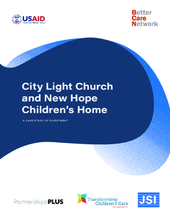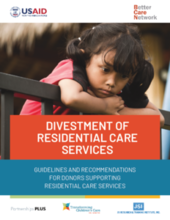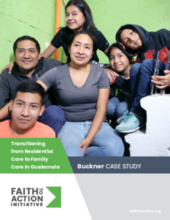The aim of this stage is to implement the strategic plan developed in phase two, towards either the goal of safe closure or of divestment from the partnership, where the decision to pursue closure or divestment was made for reasons outlined in Phase 2. Divestment could include a staged financial divestment and/or of orphanage volunteering/tourism.
Divestment is relevant for donors/partners if the residential care institution is not proceeding with changes to their model of care, despite extensive engagement efforts, and the donor/partner is concluding the partnership as a result. Divestment and closure may look quite different, as divestment may not include the social work and reintegration level processes and may conclude at this stage.
This stage is concerned with implementing the strategic plan where closure or divestment is being pursued rather than full transition. It may also be necessary to pivot and pursue divestment/closure in cases where full transition stalls or becomes untenable along the way. Process involved in closure can vary significantly depending on whether the closure is forced and/or occurring in response to uncovering significant issues (child protection/abuse serious financial misappropriation or other unlawful activity) or whether it is voluntary.
The actions that may occur in this stage are categorized under divestment and closure and may include:
Divestment:
- Informing partner residential care institutions of the intention to conclude support (funding/volunteer sending).
- Implementing a staged reduction or withdrawal of support of the residential care service/s based on pre-determined agreements and stipulated timeframes
- Connecting the partner running the residential care facility with other local organizations who can support transition should they reconsider in the future
- Resigning from boards (where donors/partners also serve on local boards of residential care institutions)
- Resolving any issues with assets (transfers, changes of name, agreement on use of assets)
- Completing concluding reports/audits/financial reconciliations as a part of ending the partnership
- Reporting any outstanding concerns or issues to local authorities and/or child protection agencies
- Developing and releasing communication materials to inform stakeholders (individual donors, volunteers, visitors etc.) of the changes
- Removing orphanage placement/product details from volunteer listings or websites
- Making changes to policies, procedures to reflect the organization’s new position on supporting residential care
- Scoping for new partnerships with organizations that support community programs/family care/ family strengthening or other non-residential services
- Conducting partnership assessments and due diligence with prospective new partners
- Forming partnership agreements with new partners
- Documenting the divestment process for internal review and learning
Closure:
- Removing or concluding the employment of staff /management that were subject to verified allegations of abuse, exploitation, serious financial misappropriation as per complaints/discipline handling policies or local laws.
- Reporting any incidents/behavior that reached a criminal threshold to the relevant authorities (at the point of it being safe for the children to do so)
- Appointing new staff/management to oversee the reintegration/closure where necessary and where former staff/management were removed
- Enacting forced closure of the residential care facility in cooperation with authorities (where necessary)
- Securing emergency alternative care for children (in the case of forced closures)
- Moving children into other forms of alternative care whilst reintegration takes place, when necessary (foster care, transit centers, small group homes)
- Developing and implementing communications and messaging plans, (taking into account what can be safely communicated in situations where there are intentions/motivations that pose a high risk) for each stakeholder group including:
- Staff of the institution
- Children and young people in the institution
- Families of children in the institution
- Care Leavers who continued to be supported by the institution and/or have siblings in care
- Community leaders
- Donors/sponsors.
- Developing and putting into place child friendly communication mechanisms to give children opportunities to continue to express any concerns they have, ask questions or provide ideas and inputs into the reintegration process. These can be communication boxes, question boards, sessions with counsellors or social workers.
- Holding one on one or small group conversations with staff after the plans to reintegrate children have been communicated. This provides opportunities to discuss staff roles and job security, and can be an important means of preventing fear, confusion, anger, or uncertainty leading to any form of intentional or unintentional sabotage.
- Discussing closure with key stakeholders (if reintegration and closure messaging and consultation was staged) and the implications for different stakeholder groups.
- Ongoing communication and consultation with stakeholders (staff, children, families, community leaders, donors)
- Arranging upskilling opportunities for staff and supporting them to find alternate employment.
- Liaising with and notifying local authorities and the registering/licensing government ministry for residential care services regarding the intention to close
- Identifying suitable referral partners in the event any cases need to be transferred or ongoing support services (such as care leaver support programs) need to be provided by other organizations post closure
- Securing the support/forming agreements with referral partners for the transfer of cases or provision of ongoing support to children and families (where external support is necessary)
- Developing and disseminating donor communication materials regarding the reintegration of children, updates on the process and the decision to close
- Supporting donors to connect with new prospective partners to retain the investment in child protection/child and family welfare services where possible
- Resolving any outstanding complaints, grievances, and child protection incident investigations/ responses
- Concluding rental agreements (where the residential care center is on a rented property)
- Monitoring the implementation of the strategic plan for closure
- Concluding staff employment and arranging severance pay where applicable.
Key milestones associated with this stage are:
- All child protection risks and concerns are addressed in preparation for safe reintegration
- The process for reintegration and closure has been clearly communicated to all stakeholders and there are mechanisms in place to address any concerns they have throughout the implementation
- All relevant authorities have been engaged and notified and any relevant legal/regulatory processes to initiate closure have commenced.
Resources
Displaying 1 - 9 of 9
The Safe and Responsible Exit Guidance developed by Catholic Relief Services provides a structured framework for organizations transitioning away from financial and technical support of residential care facilities. This guidance emphasizes ethical divestment that prioritizes child safety and supports ongoing care reform.
The Transitioning Residential Care Working Group, part of the Transforming Children’s Care Collaborative, launched the Divesting of Residential Care Guidelines and the Transition Monitoring Tool for practitioners, advocates, organization
Hace aproximadamente dos décadas, el mundo empezó a entender que los niños, niñas y adolescentes necesitan algo más que un techo y una cama.
This case study documents the complex process undertaken by a donor partner in Ireland* to push for the transition of their partner residential care service provider in Ghana. It follows their journey through the early stages of transition and eventually leads to their decision to divest of their funding and partnership.
These guidelines have been written to guide donors and partners through the process of gathering information, making the decision to divest, securing buy-in internally for divestment, engaging with partners and stakeholders, developing a divestment plan, communicating that plan, and addressing any child safety concerns.
The story of Buckner Guatemala’s transition from residential care to family care is told in this recently released Faith to Action case study. The case study details their experience through three stages of transition—learning, preparation and planning, and full transition—with transparency. It addresses common challenges for transitioning organizations, as well as the strategies Buckner took to overcome them.
This case story is meant to illustrate transition, the actors involved, the challenges and the success factors; recognizing that each transition is an individual process with different starting points, different dynamics and different evolutions. Story International’s transition example demonstrates the ups and downs of divesting from the orphanage model.
The Journey of Change and Safe Closure case story demonstrates the process of early engagement and awareness to supporting the long-term reintegration of children in families.
This document outlines 5 key steps that serve as an effective blueprint for a successful reintegration process of children and disabilities. These include ‘engagement’, ‘Assessment’, ‘Design & Development’, ‘Transition’, and ‘Monitoring & Evaluation’.








